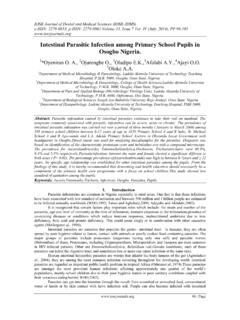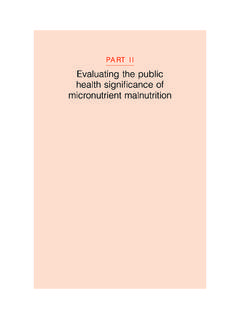Transcription of SURVEY OF INTESTINAL SCHISTOSOMIASIS AND SOIL …
1 2017 January Edition | | Innovative Association 6(1), pp: 78-90, 2017 |ISSN 2277-8330 (Electronic) Bolaji et al., SURVEY OF INTESTINAL SCHISTOSOMIASIS AND SOIL-TRANSMITTED HELMINTHIASIS among PUPILS IN IFELODUN, KWARA STATE NIGERIA. Oloyede Samuel Bolaji1*, Callistus Adewale Akinleye2, Bosede Toluwani Agunbiade3, Abiola Olasunkanmi Adeyemo1, Olaoluwa Esther Bakare1,& Oluwaseyi Adegboyega Adeyeba1 Department of Medical Microbiology and Parasitology, College of Health Sciences, Ladoke Akintola University of Technology, PMB 4400, Osogbo, Nigeria.
2 Department of Community Medicine, College of Health Sciences, Ladoke Akintola University of Technology, PMB 4400, Osogbo, Nigeria. Department of Medical Microbiology and Parasitology, College of Medicine and Health Sciences, Afe Babalola University, Ado Ekiti, Nigeria. (Received on Date: 30th October 2016 Date of Acceptance: 10th January 2017) ABSTRACT SCHISTOSOMIASIS and Soil Transmitted Helminths (STHs) are among the mainly prevalent suffering of human who live in areas of poverty in the developing world.
3 The diseases caused by STHs and Schistosoma mansoni are most commonly associated with poor hygiene practice and improper excreta disposal. This study aimed to determine the prevalence of infections with STHs, Schistosoma mansoni and the associated risk factors among school children in Ifelodun, Kwara State. It was a cross sectional study that recruited school children from 3 randomly selected primary schools in the Local Government Area aged from 3 to 18 years.
4 A well structured questionnaire was used to collect information on socio-demographic data and possible associated risk factors. A single stool sample was processed using Kato Katz thick smear technique and examined for eggs of geohelminths and S. mansoni only prevalent helminth seen was Ascaris lumbricoides (n=160). In all, female pupils had more infestation with prevalence of (7/160) than their male counterpart (3/160). Eighty percent of the infected pupils had heavy infection while 20% had light infection (P< ).
5 Thus, none of the infected pupils had moderate infection. The study confirmed absence of INTESTINAL SCHISTOSOMIASIS among pupils in the study area. KEYWORDS: INTESTINAL SCHISTOSOMIASIS , other Soil- Transmitted Helminthiasis, Pupils, Nigeria. No: of Tables: 3 No: of Figures : 3 No: of References : 28 2017 January Edition | | Innovative Association 6(1), pp: 78-90, 2017 |ISSN 2277-8330 (Electronic) Bolaji et al., INTRODUCTION INTESTINAL parasites are highly prevalent causing serious health problem in the tropics.
6 School children carry the heaviest burden of morbidity due to INTESTINAL helminths and SCHISTOSOMIASIS infections. The public health significance of Schistosome and Soil Transmitted Helminths (STH)/geohelminths continue because of their high prevalence and their effects on humans, particularly those living in the tropical and subtropical areas (Leykun, 2001). Diseases due to the parasites are among the most prevalent human infections affecting approximately one quarter of the world s population, mainly school children due to their poor sanitary conditions and their voracious eating habits (WHO, 1987; Bundy et al.)
7 , 2004). Out of the people suffering the severe morbidity of the infection, more than 150,000 results in deaths annually (Crompton 1999; Montresor et al., 2002). Numerous helminthes inhabit the INTESTINAL tract of human and those of great health importance include nematodes (roundworms) such as Ascaris lumbricoides, Trichuris trichiura, hookworms (Ancylostoma duodenale and Necator americanus) and Strongyloides stercoralis, trematodes (flukes) such as Schistosoma mansoni, Clonorchis sinensis, Opisthorchis viverrini and Fasciola spp.
8 (F. hepatica and F. gigantica) and cestodes (tapeworms) such as Taenia solium, T. saginata, Diphyllobothrium latum, Hymenolepis nana and Echinococcus granulosus. The most common INTESTINAL helminthes of humans throughout Nigeria are A. lumbricoides, T. trichiura, hookworm, S. stercoralis and Schistosoma mansoni (Odening, 1976). Others that have been reported but not very common include Taenia spp, H. nana, Dicrocoelium traspes and E. vermicularis (WHO, 1994).
9 Helminth infections caused by soil-transmitted helminthes (STHs) and schistosome are among the most prevalent afflictions of humans who live in areas of poverty in the developing world. The morbidity caused by STHs and schistosome is most commonly associated with infections of heavy intensity. Infection and transmission are propagated by poor hygienic habits such as indiscriminate disposal of human and animal faeces, which permits contact of faeces and its accompanying microbial load with soil or water.
10 In Nigeria, a considerable amount of human and animal wastes are discharged into the soil daily leading to the contamination of the soil with STH eggs and larvae (Adeyeba and Tijani, 2002). Generally, STH infections are associated with poverty, lack of sanitation, impaired hygiene and overpopulation (Ojurongbe, 2013). Infection may be direct or indirect through secondary sources such as food, water, vegetables and fruits since most STH infections are acquired through the faecal-oral route.


